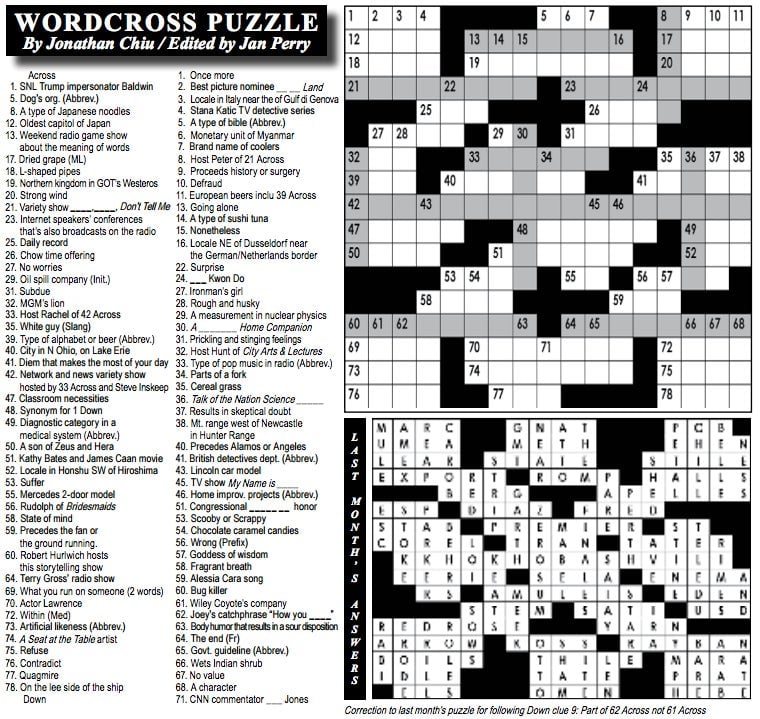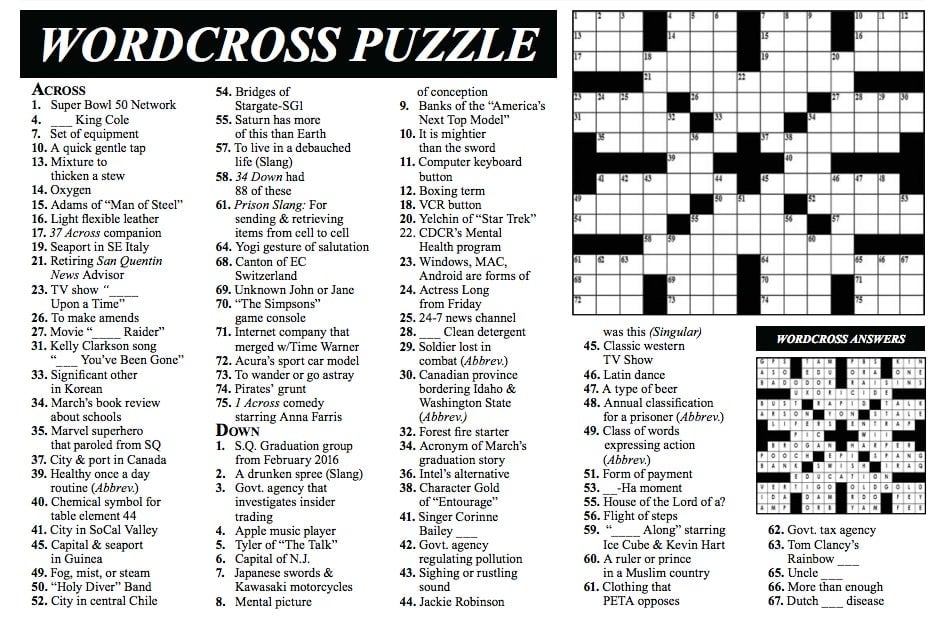The quirky San Quentin crossword puzzle features prison slang and Solange
San Quentin State Prison, California


San Quentin State Prison, California
Jonathan Chiu comes across as your classic nerdy hipster. He is a layout designer who loves the comedian Louis C.K. and Aaron Sorkin’s TV shows, like The West Wing. He writes his own standup comedy sets, and acts in Shakespeare plays. When I asked Chiu, 34, if he played sports in high school, he laughed at the idea (he is around 5’5″, and maybe 130 pounds). He is shy at first, but chatty and affable once he gets going.
Chiu writes the crossword puzzle for the San Quentin News, San Quentin State Prison’s inmate-run newspaper. As far as we can tell, Chiu’s puzzle is the only original crossword to regularly come out of a correctional facility in the United States—and perhaps the world.
The puzzle is primarily a way for Chiu, who is serving a life sentence for murder, to express his enthusiasms, of which he has many. A recent edition of the puzzle is NPR-themed. “I love NPR. I listen when I run,” Chiu told Quartz. He is part of a group of inmates who run marathons within the prison’s grounds. Only his favorite programs made it into the puzzle.
April 2017, 21 Across: Variety show, "____, ____ Don't Tell Me" [Wait Wait]
The San Quentin News is a venerable institution. It has been published off and on, depending on funding and the policies of the current warden, since 1940. The latest incarnation of the paper has been published monthly since 2013. Nearly 20,000 copies of the paper are printed and distributed for free to the 35 California prisons that hold about 130,000 inmates.
The paper’s mission is to cover the latest criminal justice news, but much like any other paper, it also offer sports and entertainment coverage as a way of attracting readers, both incarcerated and free. Chiu, the paper’s designer, started writing crossword puzzles as a way to pass the time. “I was bored out of my mind, and I figured I would be here for a while, so I decided to give it a shot,” he said. He later thought his puzzles might make a good addition to the paper.
His first puzzle for the paper was published in February 2016. Initially, the puzzle was prison-themed, and relatively easy to complete, with the goal of attracting inmates to give it a try. Clues included the names of landmarks near the prison and slang among inmates.
March 2016, 4 Across: Nickname of mountain west of San Quentin [Tam]
Lately, the puzzles have become more challenging, which Chiu prefers. They are less prison-focused, and full of his favorite things, like pop music references. One correctional officer complained the puzzle was now too difficult, Chiu said.
Writing a crossword is hard. Chiu, who is self taught and doesn’t have access to the internet, is improving as a puzzle writer, but not yet ready for primetime. We asked the New York Times crossword editor to comment on Chiu’s puzzles, and he was kindly critical. “There are many reasons why his puzzles couldn’t be published in mainstream publications like the Times,” Will Shortz said via email. “But if he’s entertaining his intended audience, I’m all for him.”

Chiu has been in prison for 13 years, and he has had an unusual experience for an inmate (beyond the fact that he writes a crossword puzzle). He has actually been given a real chance to rehabilitate. The US prison system is generally harsh and profit-driven, and not particularly good at helping the incarcerated prepare for life when they are released. Few prisons offer much more than Alcoholics Anonymous (AA), Narcotics Anonymous (NA), church groups, and General Equivalency Diploma (GED) programs.
San Quentin is one of the exceptions. Although San Quentin has an ugly reputation, earned for its past brutality and because it holds California’s death-row inmates, it is, in many ways, a model prison. Inmates jokingly refer to it as “Club Med.” Chiu, who has lived in several prisons, said “San Quentin is like no place I’ve experienced in terms of its safety and opportunities for rehabilitation.”
April 2017, 74 Across: A "Seat at the Table" artist [Solange]
The prison has more educational and rehabilitation programs than any other in the state, and an unusually large number of volunteers come to it, since it is located less than an hour’s drive from San Francisco. They offer classes in anger management, victim awareness, and cultural awareness, among others. There are also onsite college-level courses (The Prison University Project), coding classes (The Last Mile), a Ted Conference, and bicycle-repair training. Yoga and gardening groups are available.
Chiu is in prison for murdering the father of his then girlfriend’s child. He was initially reluctant to take responsibility for it, but through years of personal emotional work and programming, Chiu now sees his crime as the most selfish and horrible act he could have possibly done. “I don’t deserve it,” he responded when asked if he thought about getting out. (He is eligible to see the parole board in 2028.) “If I was the family of the person I killed, I would want that person to stay in prison.”
April 2016, 61 Across: Prison slang for sending and retrieving items from cell to cell [Fishing]
Since entering San Quentin, Chiu has participated in non-violent communication classes, restorative justice groups (programs that emphasize healing the wound of a crime for both the perpetrator and victim), and joined a support group for Asian inmates called “Returning to Our True Selves.” He says participating in these programs has changed his view of himself, and his understanding of what led to his crime. ”I didn’t know how to be in a relationship,” said Chiu. “I didn’t know how to think about others’ needs, not just my own.”

The United States puts more people in prison than any other country in the world; no country of over 10 million people has a higher incarceration rate. For most people who are incarcerated, it is not a one-time thing. More than two-thirds of those released are rearrested within three years.
State prison systems, where the majority of inmates in the US are held, are usually titled the “Department of Corrections.” Few live up to the name. A vast academic literature shows that access to educational, emotional, and vocational programs, like those Chiu has participated in, reduce the likelihood of recidivism. Yet of the over $80 billion spent on the US criminal justice system every year, only a small fraction goes to such programs.
April 2016, 35 Across: Marvel superhero that paroled from SQ [Ant Man]
In California, less than 4% of the state’s corrections budget goes to rehabilitation. In many cases, prisons are just places inmates bide their time before release. It is no wonder successful reentry to society is uncommon.
Chiu is an example of how putting resources toward rehabilitation can help people change. While it is uncertain what will happen to Chiu if, or when, he is released, there is little doubt that opportunities like working for a newspaper and participating in restorative justice will give him a better chance. It’s unfortunate that, in so many ways, his story is so uncommon.